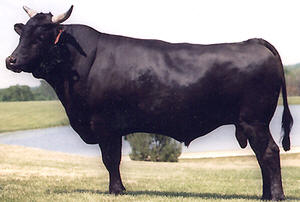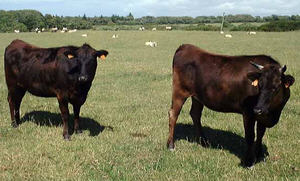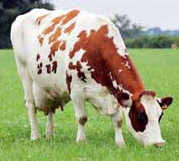



Wagyu
History
The word Wagyu refers to all Japanese beef cattle ('Wa' means Japanese or japanese-style and 'gyu' means cattle).Cattle were first introduced into Japan in the 2nd century to provide power for the cultivation of rice. Because of the rugged terrain, migration was slow and restricted. Cattle tended to be isolated in small areas and each area had essentially a closed population.
From 1635 to 1868, the cow herd in Japan was officially closed by mandate of the Shogun. And except for a short period during the Meiji Restoration in the late 1800's the national herd has remained closed to this day.
Although,there are reports that most of the cattle were influenced by British and Continental breeds for a few generations nearly 100 years ago. Brown Swiss, Shorthorn, Devon, Simmental, Ayrshire, Korean, Holstein and Angus had been imported by 1887 and impacted today's Wagyu.
Crossbreeding was prominent for several years, but when the price of crossbreds collapsed in 1910 no further crossbreeding was conducted. The result was selection for specific traits determined by region and extensive linebreeding was used to achieve those traits.
The dominant black Wagyu strains are Tottori, Tajima, Shimane, and Okayama. Tajima cattle, bred in the Tajima region, were originally chosen and bred for their heavy forequarters because their primary use was to pull carts.
 Photo courtesy of Lone Mountain Cattle, www.lonemountaincattle.com |
The other main "breed" of Wagyu, was developed on the island of Kyushu and are red in colour. As with the blacks, there are two distinct strains-Kochi and Kumamoto. Kochi cattle were strongly influenced by Korean breeding while Kumamoto are believed to have considerable Simmental influence.
The original import of these cattle to the U.S. in 1976 consisted of two Tottori Black Wagyu and two Kumamoto Red Wagyu bulls. That was the only importation of Wagyu into the U.S. until 1993 when two male and three female Tajima cattle were imported and 1994 when 35 male and female cattle consisting of both red and black genetics reached the U.S.
Japan's rugged terrain created isolated pockets in which different breeding and feeding techniques were used. This resulted in distinctly different characteristics which, over the years, led to cattle from the Kobe region becoming a standard for the world in terms of flavor and tenderness. Since then, two decades of research and development have resulted in an eating experience unequaled by any domestically produced beef today. Every bite bespeaks a quality that, until now, was unavailable in this country at an affordable price.
These feeding practices have come about through belief and science, such as feeding the cattle beer. Beer is fed to the cattle during summer months when the interaction of fat cover, temperature and humidity depresses feed intake. Beer seems to stimulate their appetite. It's merely part of the overall management program designed to keep the cattle on feed in the heat of the summer.
They are also known to massage their cattle too. The massaging is done to relieve stress and muscle stiffness. It's believed that the eating quality of the meat is affected positively by keeping the cattle calm and content.
Another practice common amongst Wagyu cattle breeders is the brushing of the cattle coats with Sake, producers in Japan believe that haircoat and softness of skin are related to meat quality. It's believed brushing the haircoat with sake improves the appearance and softness of the animal and is therefore of economic importance.
Also: Wagyu History by Kiyoshi Namikawa
Characteristics
Wagyu have a coat colour of black or red, their horns are straight to slightly curving forward and start off a whitish colour then darken to black at the end.They are known for their peaceful temperament, some think that it is because of their history with their special way of being grown.
Wagyu and the specialised growing techniques have given rise to the famous Kobe beef, which is a very tender, very marbled beef carcase.
Wagyu cattle are unusually healthy cattle and readily adapt to a wide range of climatic conditions.
Lower birth weights allow greatest calving ease. 30-40 kg are a representative range of weights for Wagyu calves.
Wagyu cattle are very fertile and most females cycle before twelve months of age. Bulls can reliably service 50% more females than most other breeds.
Wagyu cattle have superior beef conversion and the ability to marble on both grain and pasture feeding. When crossed with other breeds Wagyu increases marbling, improves the quality grade and adds more consistency to carcass quality.
Statistics
 Photo courtesy of Chateaux Wagyu, www.wagyu.net |
- Carcase Production
- Calving ease
- Marbling
- Fertility
- Softer fat composition: higher ratio of unsaturated fats - flavour
- Quiet temperament
- Meat texture is finer
- Versatile adaptation to environments
- Not excessive back fat
- Early female maturity
- Rib eye Yield
Comparative
2001 National Wagyu Sire SummaryMeat
It's fairly easy to make claims about flavour and tenderness because in most cases, those qualities are very subjective. But Kobe Beef America™, Inc., working in conjunction with the food scientists at Washington State University, has compiled quantifiable data to back up the claims.
In research conducted at the University it was learned that on comparable grade basis, where overall palatability, flavor, and tenderness were the main criteria, the American Wagyu out performed all other breeds on a consistent basis.
Shear Testing And Laboratory Trained Test Panels
Tenderness was quantified by using a highly sensitive coring machine to measure shear resistance.
For flavor and palatability, a laboratory - trained taste panel was used in addition to a consumer panel. The findings of these groups confirmed the hypothesis of the food scientists. American Wagyu was judged superior in overall palatability. It also stood "head and shoulders" above the others when the combined characteristics of flavor, tenderness and palatability were considered.
The Japanese Meat Grading System
Distribution
Wagyu cattle have been exported from Japan to Europe, Chile, Canada, New Zealand, Australia and the USA.References (the above information was cited from the following sites)
www.ansi.okstate.edu
www.kobe-beef.com
http://wagyu.une.edu.au
www.ansci.wsu.edu
www.lonemountaincattle.com
www.wagyu.net


